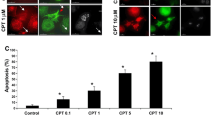Abstract
It has been examined whether the destruction of cell microtubules affects the increase in the intracellular hydrogen peroxide concentration caused by sodium arsenite, which induces the formation of stress ribonucleoprotein granules. As expected, sodium arsenite caused a 50% increase in hydrogen peroxide concentration in HeLa cells; on the other hand, another stress granule inducer tert-butylhydroquinone did not affect the peroxide concentration. The disruption of microtubules by nocodazole or vinblastine also resulted in some increase in the intracellular peroxide concentration, and the microtubule stabilization by taxol did not affect it. The combined treatment of cells with arsenite and antimicrotubule drugs caused an additive effect, and the peroxide concentration increased twice or more. Thus, the inhibition of stress granule formation after microtubule disruption cannot be explained by a decrease in peroxide concentration as compared with the affect of arsenite.
Similar content being viewed by others
Abbreviations
- tBHQ:
-
tert-butylhydroquinone
- CM-DCF-DA:
-
5-(6)-chloromethyl-2′,7′-dichlorodihydrofluoescein diacetate
- DMSO:
-
dimethylsulfoxide
- PBS:
-
phosphate-buffered saline
- RNP:
-
ribonucleoprotein
References
P. A. Ivanov and E. M. Chudinova, Exp. Cell Res. 290, 227 (2003).
E. S. Nadezhdina, A. J. Lomakin, A. A. Shpilman, et al., Biochim. Biophys. Acta 1803(3), 361 (2010).
S. Kwon, Y. Zhang, and P. Matthias, Genes Dev. 21, 3381 (2007).
E. Kolobova, A. Efimov, I. Kaverina, et al., Exp. Cell Res. 315, 542 (2009).
K. G. Chernov, A. Barbet, L. Hamon, et al., J. Biol. Chem. 284, 36569 (2009).
J. Kedzior, M. Masaoka, C. Kurono, et al., J. Electron Microsc. 53(6), 659 (2004).
L. Zuo, M. Ushio-Fukai, L. L. Hilenski, et al., Arterioscler. Thromb. Vasc. Biol. 24(7), 1223 (2004).
L. Pentassuglia, F. Timolati, F. Seifriz, et al., Exp. Cell Res. 313(8), 1588 (2007).
J. Alexandre, Y. Hu, W. Lu, et al., Cancer Res. 67(8), 3512 (2007).
R. Kahl, S. Weinke, and H. Kappus, Toxicol. 59(2), 179 (1989).
C. P. LeBel, H. Ischiropoulos, and S. C. Bondy, Chem. Res. Toxicol. 5(2), 227 (1992).
N. A. Shanina, P. A. Ivanov, E. M. Chudinova, et al., Mol. Biol. 5(4), 638 (2001).
R. Samarakoon, C. E. Higgins, P. Stephen, et al., Cell Signal. 21(6), 986 (2009).
M. Ozaki, S. S. Deshpande, P. Angkeow, et al., J. Biol. Chem. 275(45), 35377 (2000).
M. C. Duyndam, T. M. Hulscher, D. Fontijn, et al., J. Biol.Chem. 276(51), 48066 (2001).
D. K. Jung, G.-U. Bae, Y. K. Kim, et al., Exp. Cell Res. 290, 144 (2003).
Y. C. Chen, S. Y. Lin-Shiau, and J. K. Lin, J. Cell Physiol. 177(2), 324 (1998).
B. R. Imhoff and J. M. Hansen, Cell Biol. Toxicol. [Epub ahead of print] (2010).
Y. Nakagawa, K. Nakajima, G. Moore, et al., Eur. J. Pharmacol. 270(4), 341 (1994).
T. Okubo, Y. Yokoyama, K. Kano, et al., Food Chem. Toxicol. 41(5), 679 (2003).
Author information
Authors and Affiliations
Additional information
Original Russian Text © E.M. Chudinova, E.S. Nadezhdina, P.A. Ivanov, 2010, published in Biofizika, 2010, Vol. 55, No. 5, pp. 857–861.
Rights and permissions
About this article
Cite this article
Chudinova, E.M., Nadezhdina, E.S. & Ivanov, P.A. Is the microtubule disruption-induced alteration of peroxide concentration a factor inhibiting the assembly of ribonucleoprotein stress granules?. BIOPHYSICS 55, 756–759 (2010). https://doi.org/10.1134/S000635091005012X
Received:
Published:
Issue Date:
DOI: https://doi.org/10.1134/S000635091005012X




